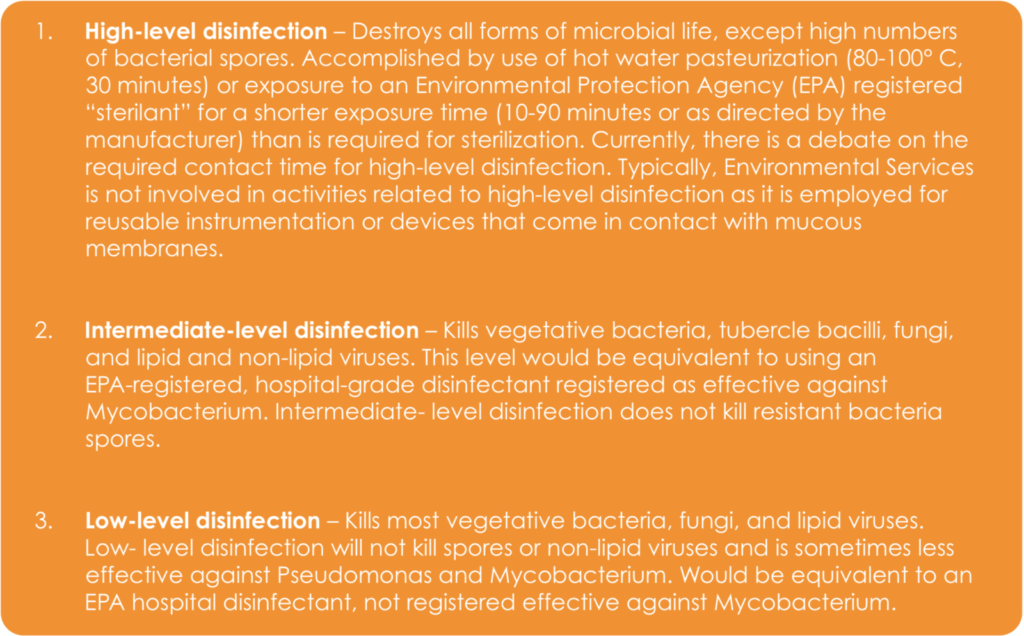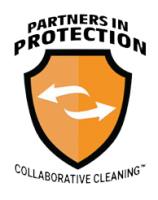CHEMISTRY OF CLEANING & DISINFECTING
Cleaning and Disinfection

Cleaning is always essential prior to disinfection or sterilization. A surface cannot be considered properly disinfected or sterilized if it has not been cleaned. Organic material left on a surface or medical device can shield microorganisms and protect them from the action of disinfectants or interact with the disinfectant to neutralize the activity of the process.

Environmental services departments are typically responsible for cleaning and disinfecting the various types of equipment and furniture, floor and wall coverings, window treatments, lights and other fixtures, surfaces and finishes on counters, desks, etc. There are three basic elements to be determined and managed in cleaning operations: the solutions and/or chemicals needed to clean and/or disinfect the surface, the tools and equipment needed, and the labor resources required to properly execute the process.
Chemicals
Determining the proper chemicals to clean or disinfect the various surfaces found in a health care environment is often a challenge. The chemicals should not damage the finish, yet should effectively remove the soil or stains from the surface. When new finishes or equipment are installed in a facility, a copy of the manufacturer’s recommendations for cleaning should be reviewed. If the recommendations are unclear, Environmental Services should contact the manufacturer directly to clarify.
In some cases, manufacturer’s warranties may be voided if surfaces, finishes or equipment are not maintained according to their recommendations. Therefore, special attention must be paid to all documentation regarding manufacturer recommendations and warranties. All documents and correspondence should be maintained in an accessible file for future reference.

There are five basic elements involved in cleaning with chemicals: contact time, temperature, concentration, mechanical action, and pH. Contact time refers to how long the chemical is in contact with the surface. Generally, the longer the solution is allowed to work, the more effective the result.
Temperature refers to the recommended cleaning solution temperature range. In the past it was commonly believed a hot solution would perform better. Presently, chemicals are formulated to be used with warm or cold water; therefore, it is vitally important to follow the manufacturer’s recommendations. There are temperature ranges associated with cleaning various fabrics and carpets to prevent damage to the fibers, so it is also important to be sure the solutions and the temperature are compatible with the textile manufacturer’s recommendations.
Concentration refers to the strength of the chemical when diluted with water. Chemicals are often pre-mixed according to manufacturer recommendations through dilution systems. Some bulk chemical products, such as strippers, provide for a varied dilution range, depending on the strength needed to perform the job.
Mechanical action is the process that agitates or displaces unwanted matter from a surface. Agitation may occur by using brushes to dissolve solids and liquids. Displacing unwanted matter using friction by hand or with powered equipment will yield better results. Rigorous or aggressive mechanical action could damage some surfaces. Manual or mechanical friction, as well as the chemical used, should be appropriate for the surface.
The pH scale measures the level of acidity or alkalinity in a solution. The scale’s range is 0 to 14. Chemicals with a pH of less than 7 are acidic; chemicals with a pH of 7 are neutral and less aggressive, while chemicals with a pH of 8 to 14 are alkaline. Acidic solutions are aggressive and can damage or etch surfaces with frequent use, because the protective layer of the surface is weakened or removed. Rinsing with cold water often stops the reaction of the acid with the surface to reduce potential damage.
Neutral solutions (pH of 7) are generally safer to use for the finish, the surface, and the user. Generally, alkaline solutions have a higher concentration of detergent (soap) which could lead to residue buildup on the surface. Be aware that the layer of chemical that remains allows dirt and microorganisms to adhere to the surface.
There are many different cleaning solutions available for use in the healthcare environment. General-purpose cleaners will penetrate some soil and dirt while other chemicals are designed for specific use on a certain type of soil load or surface. Most soils and stains are either protein-based or solvent-based. If the type of soil or stain is known, a cleaner specifically designed to remove that type of soil or stain will be the most effective. It is important to test the chemical prior to use to ensure it will not damage the surface. A good rule of thumb is to first employ the less aggressive chemical to clean a surface, only using “stronger” chemicals if the initial results are not acceptable.
Carpet or upholstery cleaning presents different challenges than other surfaces, primarily due to the wide variety of textile fibers, durability, and stain resistance. It is extremely important to consult the manufacturer’s cleaning recommendations for carpet and upholstered surfaces to determine the proper cleaning methods that can be used without damaging or voiding warranties. For example, fabrics requiring a solvent-based cleaning chemical cannot be cleaned by more common water-based fabric cleaners. There are many specialty carpet and upholstery cleaning solutions available. Manufacturers and distributors of these products are a good source to determine which products will perform well on the carpeted or upholstered surfaces in a facility.
Disinfectants
To protect residents, family and staff from potential exposure, it is vitally important to prevent the healthcare environment from becoming a reservoir of pathogenic (harmful) microorganisms. The environmental services department typically has the responsibility of cleaning and disinfecting most inanimate objects and surfaces in health care facilities. Since there are many potentially pathogenic microorganisms in a healthcare environment, these surfaces must be cleaned and disinfected often. Environmental Services management should work with the Infection Preventionist (IP) to determine requirements for disinfection.

The Center for Disease Control and Prevention (CDC), adopted the classification scheme first proposed by Spaulding who classified disinfection at three levels: high, intermediate, and low. The level of disinfection is dependent on the item to be disinfected and the intended use of that item. These disinfection levels are defined as follows:

The different surfaces and finishes in a facility will often dictate which chemical products are necessary, but it is always preferred to minimize the number and variety of chemicals used whenever possible and without compromising the cleaning process, infection prevention and patient safety. Minimizing chemicals is environmentally friendly, simplifies staff training, reduces the risk of improper chemical usage by an employee, and reduces the risk of hazardous chemical combinations being used. It is the responsibility of the Environmental Services Department to be educated in the newest technologies and their effectiveness and to do everything possible to ensure the safety of patients, staff, and others in the facility.




